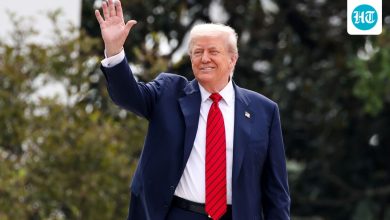Government shutdown threat looms: What makes it different from past crises?

The United States government faces a shutdown at midnight on Tuesday if the Republicans and Democrats fail to reach an agreement on temporary funding. While government shutdowns are not new, this one carries a unique weight. It is unfolding against the backdrop of President Donald Trump’s sweeping attempts to expand executive power, turning a budget dispute into a battle over constitutional limits and political control, reported CNN.
If Congress fails to pass a conciliatory budget by September 30 midnight, the US would be looking at a government shutdown.(Bloomberg)
What is at risk?
If Congress does not act, large portions of the government will grind to a halt. Thousands of workers could be furloughed, from NASA staff to national park rangers. Essential employees will continue working but without pay. Federal courts may have to close, and small business grants could be delayed. The stakes are high: $1.7 trillion in discretionary spending, roughly one-quarter of the government’s $7 trillion budget, is due to lapse, added a Reuters report.
Also Read: Government shutdown looms ahead of high-stakes meeting: Here’s what stays open and closed
A political fight over more than money
As per a CNN report, unlike previous shutdowns, which have centered on funding policy, this impasse is tied to Trump’s broader agenda. Democrats are insisting on an extension of Affordable Care Act subsidies that support keeping healthcare costs under control for 24 million Americans. Without action, premiums could spike, and rural hospitals may face closure. Republicans, however, want to pass a temporary bill first and negotiate healthcare later.
Senate Democratic Leader Chuck Schumer has warned that the cuts could devastate families and medical research, saying there will be “huge pressure” on Republicans to engage in serious talks. Senate Republican Leader John Thune countered that Democrats were “holding the American people hostage” by tying healthcare to government funding, the Reuters report stated.
Also Read: Government shutdown: When was the last time federal funding was cut off? Complete timeline
Trump’s expanding power moves
The funding impasse has come at a time when Trump has ramped up his use of presidential authority. In the past few weeks, he has sent federal troops to Portland in the midst of protests, urged prosecutors to bring charges against political opponents, questioned established rights of citizenship, and attacked public health recommendations on vaccines. Democrats claim that the fight over the shutdown is just one part of a bigger fight over the question of whether the president can be checked by Congress, the CNN report stated.
History of shutdowns
There have been 14 partial government shutdowns since 1981, with most lasting only a few days. The longest shutdown, from 2018–2019, lasted 35 days, reported Reuters. In the usual course, political risk takes its toll on both sides as shutdowns raise the ire of the populace and cause harm to the economy. But signs indicate that Trump appears not to care much about long-term ramifications, CNN reported.
Also Read: Government shutdown: What happens after federal funding is cut off?
Democrats’ risky gamble
Democrats have a painful choice to make: risk a shutdown to push through their healthcare demands or back off and appear feeble before their supporters before the 2026 midterms. Some lawmakers fear backlash should they be blamed for the disruption. Others maintain it is a stand that must be taken against Trump’s bullying tactics.
With the deadline set for Tuesday rapidly approaching, a potential standoff threatens to redefine government funding, if not take hold of the entire vista of political power.
FAQs:
Q1: When will the government shut down if no deal is reached?
At midnight on Tuesday, federal funding will expire, triggering a shutdown.
Q2: What services would be affected?
National parks, NASA, federal courts, and small business grants could be disrupted. Essential services will continue, but without pay for employees.
Q3: How is this shutdown different from past ones?
This shutdown is tied not just to budget disagreements but also to Trump’s broader push for executive power and Democrats’ fight to protect healthcare subsidies.




